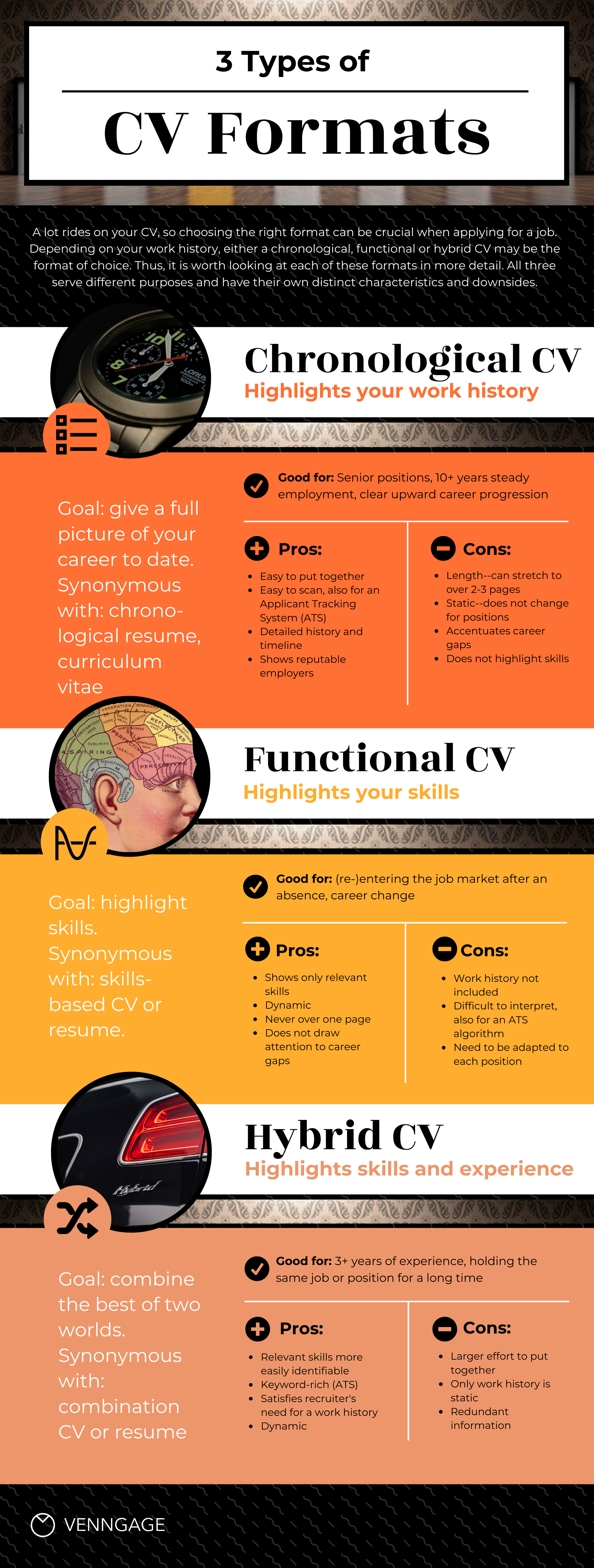How to choose the right CV format for your job application
Choosing the right format for your CV can be crucial. The three most commonly used types of CV formats are: chronological, functional and functional-chronological or hybrid CVs.
A lot rides on your CV when you’re applying for a job, so it’s worth looking at these formats in more detail. Each serves a slightly different purpose and has its pros and cons (see infographic below).
The chronological CV
A chronological CV is a full record of your career to date. It gives exact information about the job titles you’ve held, for how long as well as your duties and responsibilities for each employer. The level of detail is high. As a result, a chronological CV can stretch to over 2-3 pages.
A chronological CV is also static, meaning it does not change for the positions you’re applying for. So, once you’ve written a nice typo-free CV, you can use it again and again.
The chronological format is often prioritized for senior or executive positions because it shows career progression. So if you’re someone with 10+ years of steady employment reflecting a clear upward career progression with increased responsibilities, then this is the format that best tells your career story. Chronological CVs also offer an advantage if you’ve worked with well-known companies because you list company names–as opposed to the functional format.
Another big advantage of chronological CVs is that they’re easy to scan. That’s why the chronological format is also a favorite for online applicant tracking systems (ATS) used by employers to filter out unsuitable job candidates. Other formats are not as easy to interpret for a machine.
On the downside, a chronological CV may draw a recruiter’s attention to lack of experience or career gaps you would rather not want to highlight. Therefore, if you are (re-)entering the job market or considering a change of career, you might want to consider a different type of CV.
Because of their length, chronological CVs take longer to interpret, and not all recruiters want to take the time to read through your life history, especially in more competitive job markets. Thus, it’s important to make your work history easily scannable.
Conclusion: A chronological CV is a good choice for job seekers with a strong, solid work history.

The functional CV
A functional CV does not include a work history. It only presents relevant skills. The goal is to construct a professional identity that is relevant to the requirements of the job you’re applying for. As a result, a functional CV needs to be adapted to every position you apply for. So it’s a dynamic document, not static like a chronological CV.
Only key strengths are highlighted. Your experience and achievements are listed under ‘functional’ headings, which represent the skills an employer is looking for (e.g. ‘communication skills’). As a result, it’s never more than 1 page long.
Showcasing skills instead of experience
Because your skills are the focal point, you do not draw attention to lack of experience so it’s the perfect format for students or recent graduates or people transitioning between industries. You don’t accentuate gaps in your work history which is a big advantage for people re-entering the job market after a while.
There are a few downsides, though. From a recruiter’s perspective, a functional CV is not as straightforward as a chronological CV and thus harder to review. There is no real ‘career story’ a recruiter can follow if you don’t list and explain each of your previous positions. Furthermore, recruiters may regard a functional CV with suspicion. Many are specifically trained to spot “job hopping” or inexplicable career gaps. And last but not least, a functional CV also does not fare too well with algorithms.
Conclusion: A functional CV is the best option if highlighting skills is the best way to showcase your suitability for a job.
The best of both worlds: the hybrid CV
Then there is the mixture of the two: a functional-chronological or hybrid CV. With this type of CV, you list the skills and qualifications that are relevant to the job you are applying for as well as provide your chronological work history. However, the work history is concise and should not take up more space than the skills part.
With a hybrid CV, you combine the best of both worlds. Because it’s a carefully curated document, putting it together is a bigger effort. Only your work history is static.
Conclusion: Good choice for job seekers with a consistent work history, e.g. if you worked for the same employer or held the same position for a long time.
How to write a hybrid CV is explained in this video tutorial from Zentrum Schreiben:
Further reading and watching
This is very helpful information, not only for students. Good to know that it's there. Thank you, Jacqueline Vitacco.